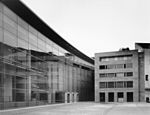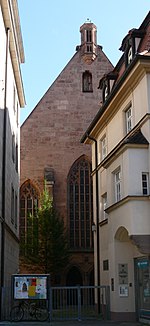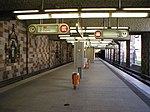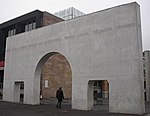Aufseßplatz station

Aufseßplatz station is a Nuremberg U-Bahn station, located on the U1 line. An unused tunnel stub for a connection curve exists south of the station on the side of the north-bound track. This curve was meant as connection to another subway line from Plärrer to Dutzendteich, which never got beyond an early planning stage. Like Plärrer, Hauptbahnhof and the much later Friedrich Ebert Platz orange tiles were used to indicate a possible interchange station. However, as of 2022 only Plärrer and Hauptbahnhof actually are interchange stations between different subway mainlines. While Aufseßplatz is also served by Tram line 5, this is a distinction three other stations (Rathenauplatz station, Frankenstraße station, Wöhrder Wiese station) share in addition to all four "orange tiled" ones.
Excerpt from the Wikipedia article Aufseßplatz station (License: CC BY-SA 3.0, Authors, Images).Aufseßplatz station
Wölckernstraße, Nuremberg Galgenhof
Geographical coordinates (GPS) Address Nearby Places Show on map
Geographical coordinates (GPS)
| Latitude | Longitude |
|---|---|
| N 49.4404234 ° | E 11.0809894 ° |
Address
Wölckernstraße
Wölckernstraße
90459 Nuremberg, Galgenhof
Bavaria, Germany
Open on Google Maps










